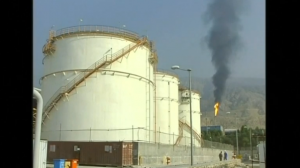 REUTERS — Global oil prices are expected to remain low in the near future according to analysts, even though the price has lately climbed to about 30 U.S. dollars a barrel.
REUTERS — Global oil prices are expected to remain low in the near future according to analysts, even though the price has lately climbed to about 30 U.S. dollars a barrel.
On Monday, the West Texas Intermediate for March delivery moved down 1.85 U.S. dollars to settle at 30.34 dollars a barrel on the New York Mercantile Exchange, while Brent crude for March delivery decreased 1.68 dollars to close at 30.5 dollars a barrel on the London ICE Futures Exchange.
Crude oil prices began to recover when the United States faced a patch of extreme cold weather last week, while Europe raised hopes of more economic stimulus measures.
However, the global oil price has fallen by more than a quarter since the start of this year.
Iran announced last week that it would increase production since US and EU sanctions have now been lifted. In reaction to this news, Benchmark Brent crude dipped below 28 U.S. dollars a barrel, hitting its lowest level since 2003.
Analysts said the current oil prices can’t been seen as the start of any long-term rebound.
“The crude oil price depends on three major factors: supply, demand and the U.S. dollar. The supply part is very messy, as both Iran and Saudi Arabia announced that they would increase their output. However, the demand remains rather weak. Besides, the U.S. dollar has been in a hiking cycle, with more rate hikes very likely to be seen this year. For all these reasons, the oil price will stay low this year,”said Cao Yin, a chief analyst on energy at Cinda Securities.
Cao estimated the price of oil would see fluctuations of between 25 and 40 U.S. dollars a barrel throughout 2016.
Though the Middle East is ramping up its production levels, China National Offshore Oil Corporation(CNOOC), one of China’s major oil producers, says that it will cut its oil and gas production by between 10 and 25 million barrels this year. It’s the first time since 1999 that the leading Chinese oil company has announced such a reduction.
Cao said this move has been taken for the purpose of reducing costs.
“The CNOOC mainly exploits undersea oil and gas, so its cost per barrel is higher than those oil companies that produce oil onshore. The company bought Canadian oil company Nexen two years ago at a cost of more than 10 billion US dollars. However, the oil price began to plummet soon after the deal and there’s no sign of recovery in the short and mid term. Nexen’s recent scandals involving explosions, leakage and pollution have also troubled the CNOOC,” explained Cao.
The analyst also feels China’s other top two oil producers Sinopec and PetroChina were unlikely to cut their outputs this year, as both have sufficient oil resources and enjoy favorable policies from the government.
Cao instead predicted that PetroChina might in fact increase production to ensure the country doesn’t depend too heavily on foreign imports.








